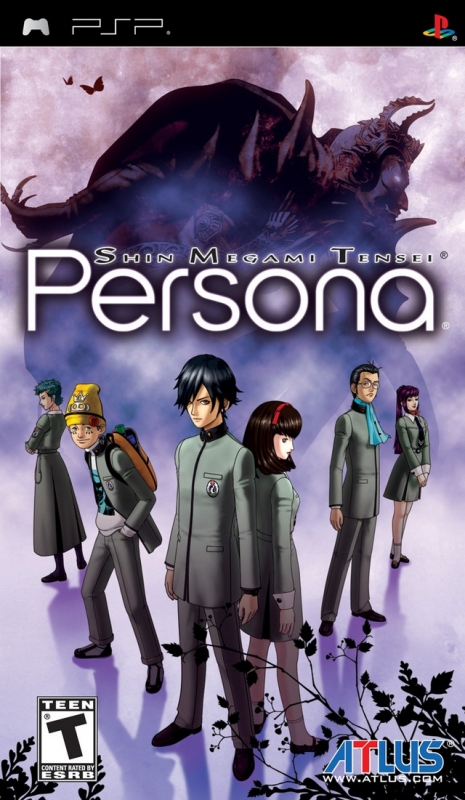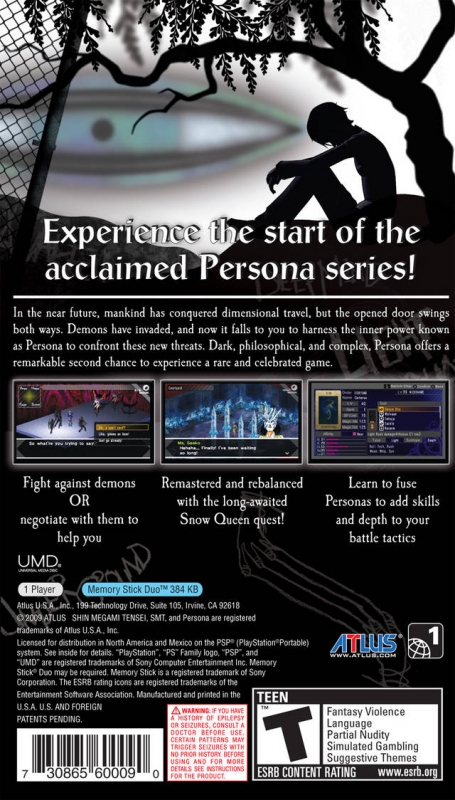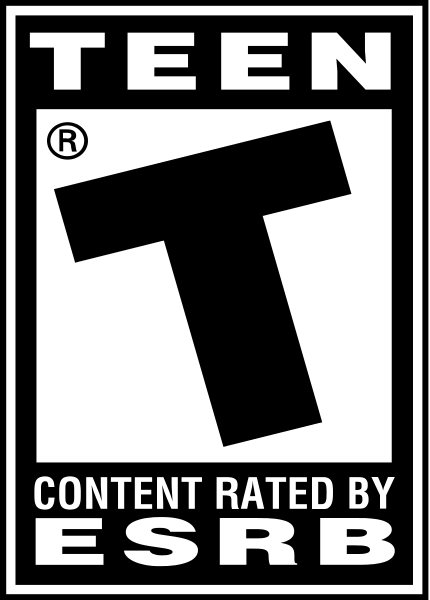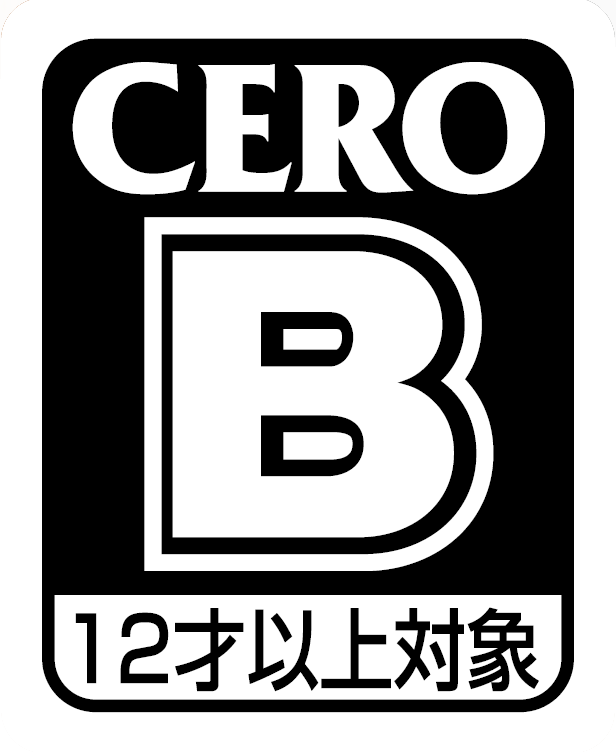Existing User Log In
New User Registration
Register for a free account to gain full access to the VGChartz Network and join our thriving community.





America - Front


America - Back



Persona
ペルソナ
Atlus Co.
Role-Playing
 09/22/09 Atlus
09/22/09 Atlus  04/29/09 Atlus
04/29/09 Atlus  (Add Date)
(Add Date)
| Owners: | 95 | |
| Favorite: | 2 | |
| Tracked: | 0 | |
| Wishlist: | 16 | |
| Now Playing: | 1 | |
After the breakout success of games like Shin Megami Tensei: Persona 3 and 4, Atlus found itself with a new audience of fans of their flagship JRPG series. Therefore, it was only natural for them to try and show that new public how it all began. Thus, a port of the very first Persona (released for the PS1 in 1996 and sadly famous for being one of the worst localization jobs ever, with quests removed and an “all your base are belong to us”-like translation) was made for the PSP. How does this first game look to someone who was introduced to the series with newer games like Shin Megami Tensei: Nocturne and Persona 3?
If you played any Persona game before then you know what to expect from the setting of the game: a typical (or is it?) Japanese city where you take command of a mute high-school student (whom you can name) and his group of friends. At the start of the game, your friends are successful in their bid to summon an urban legend called “Persona” by performing a ritual. A man called Philemon emerges and tells everyone about the hidden powers they can use; their own Personas. It’s not too long until they can put those new found powers to use, as a weird chain of events infests the city with demons, and of course it’s up to you and your friends to find out what’s happening and save it.
The story has its ups and downs. It starts off strongly (though a bit accelerated, and you may struggle to keep up with the pace), but then falls into a couple of the clichés that are so common in the genre. Especially disappointing is the main villain, Kandori, who fails to show any interesting attributes and ends up being very forgettable. The strongest aspect of the story is found in your party members, who show interesting development and interactions between one another. While you can easily categorize each one into a stereotype (Nanjo is the intelligent kid, Brown is the one that likes to show off, Mark is the one most prone to screw-ups, and so on), they show good depth and evolution during the course of the game.
The demon collecting and fusing system that’s the trademark of the series is still here. But let’s start from the beginning. Persona has three navigating modes: the map screen, where you move an object shaped like a human body around the streets of the city, the safe rooms (like shops or treasure rooms), where you control your character from an isometric perspective, and the dungeons, which are in first-person view. Whilst over the map or in dungeons, battles occur randomly. You can use up to 5 characters in battle (the main story gives you 5 characters, but there are some more you can recruit by doing side-quests, so if you want to swap members you have to explore a bit). The random battle frequency is a tad high, but thankfully both battles and load times are short enough, so it doesn't become tedious. Battles play in turn-based fashion, with you setting all your party's commands beforehand and then they’re played according to speed. Much appreciated is a “skip” function that allows you to cut drastically battle animations - it speeds up the game exponentially and more games should use it.
During battle, each character can attack, guard, fire their gun, change their Persona, or use a special skill. Each character has a different range for their melee and gun attacks, and that’s why it’s important to place them properly in a grid, as that determines which opponents they can attack (and conversely, which attacks they receive). Sometimes grid placement can be a bit annoying, as I never seemed to find the perfect combination, but it adds some more customization to the game. But as I mentioned before, the biggest draw of the game comes from recruiting and fusing demons. At any moment of the battle (except when fighting bosses), you can try to initiate a conversation with any of the demons you’re fighting against. The demon will have a set of traits, like “foolish”, “timid”, “haughty” and so on; each of your party members has 4 different conversation options they can perform, and it’s up to you to pick the most suitable one. After choosing, you exchange words with the demon, and you can see the results of your action in a panel, showing how “eager”, “angry”, “scared” and “happy” it is. If you get the “eager” indicator to maximum, you can ask him for a card (that he may or may not give), which are what you'll often be seeking from negotiations. The conversation system is very random, which is what makes it entertaining. You can never be sure how the monster will react. Although there are patterns that work best (for example, for “wise” demons it’s best to use Nanjo’s "Pontificate", for “forceful” demons Maki’s "Cringe" works very well, and so on), there’s always a chance that the monster might get angry, they might ask you for money, or they might give you a huge amount of experience; you can never know for sure.
Once you have the card, you can’t do anything with it until you fuse it. Here, you combine two cards to make a Persona for any of your party members to use. Each character can hold up to three Personas, one being the active one and the other two able to enter stage with the "Change Persona" command (at the cost of one turn). Personas determine the special skills you can use, and there are a lot of them: healing magic like Dia, attack magic like Bufu, Gry and Megido, status inducing magic like Makajam, physical skills like Bonecrusher, and more. If you’ve played an SMT game before, you’ll know most of those names and their effects, but if you’re new to the series, expect to be confused a lot with the names. And that’s not the only thing that could confuse you, as the game is not exactly user-friendly. While it does introduce you to the concepts of the game like attacking, using Personas and such, the game leaves you in the dark in some other aspects, like with the formations or the different magic types. The worst offender is without a doubt the lack of any proper explanation about the different status effects. For example, I can imagine what happens if my character reads “Shk” and it has a lighting icon on him (it means it can’t attack), but what am I supposed to make of an icon that tells me nothing when my character reads “Ulu”?
Navigating maps and dungeons isn’t as smooth as it should be. Controls are especially imprecise on the map screen - movement isn’t precise, and it may require a few tries to enter certain places. This wouldn’t be a problem if it weren’t for the fact that not turning properly on a corner could trigger another random battle. The controls are bad in the safe rooms too, but since at least here there aren’t any encounters, you can try to position your character properly to talk to an employee or to open a treasure chest all you want without consequences. In the first-person dungeons, luckily there aren't any control problems, the issue here arises from a dubious dungeon design that has more dead ends than necessary, causing quite a bit of frustration. What’s more, the automap feature (to which you’ll pay more attention than the barren dungeon screen) isn’t very intelligent. When you see a dead-end on the main screen in a game like this, you normally don't walk all the way to the end before turning around. The problem is that the automap may not register it as a dead end, instead showing it as an unexplored passage, therefore in the trickier mazes you'll often not know whether or not a passage is genuinely unexplored.
Persona doesn’t try to hide the fact that it’s a 13-year old port in any way. Other than the new anime cutscenes (which look great), the graphics are that of an early PS1 game. The dungeons are dull and feature the same texture repeated over and over, and the in-game cutscenes are just an interchange of text-dialog boxes with at most one moving sprite showing a reaction. Of course, it’s hard to expect anything better, and it’s certainly playable. Just know that if you need pretty graphics in your RPG you should stay away from this game. The music has been totally remade for this port, and what was dark techno is now mostly J-Pop. I usually don’t mind this, and I still count Persona 4’s battle theme as one of my favorites, but here it’s overdone and of less quality than its predecessors (or sequels, if you want to put it that way). The normal battle theme in particular can get repetitive quickly, because it’s so over-the-top. If you’re a fan of J-Pop, you may like the soundtrack, but this is definitely not one of Shoji Meguro’s best. Voice acting fares better. While there’s not a whole lot of it (only in the anime cutscenes), I didn’t notice any character that annoyed me in particular.
How much playtime you’ll get from Persona will depend on your commitment to explore different paths. For players that don’t check every nook and cranny at every step, or play to get the “best ending” at every RPG, this will mean around 20 hours to get one of the most disappointing endings I’ve ever witnessed in a video game. There’s a junction point in the middle of the story (at least the game’s kind enough to tell you that the decision is game-changing) that gives you a different ending depending on your answers. I can’t stress this enough: check in a walkthrough what you’re supposed to say to get the good ending (or at least keep a save before that point), otherwise you’ll feel like you’ve wasted a lot of time for nothing. Should you aim for the good ending (which, I repeat, you should), you’d be adding around three to five more hours for a much more fulfilling finale.
There is some semi-new content in the game that sets Persona PSP apart from the original PS1 game, and it's called the Snow Queen Quest. This quest was in the original Japanese version of the game, but it was cut out in the localization completely. Now playable for the first time in English, the option to take this path is at the very beginning of the game, and again, you’ll only find it if you’re very thorough with exploring or use a walkthrough. This path features a complete different storyline, with different events not related to the main story, so it’s something you should check out. The Snow Queen quest and the main quest are mutually exclusive (you can’t take both at the same time), and since the difficulty level is a bit harder here, it’s something you should reserve for a second playthrough.
Speaking of difficulty, it’s one of the things I found most disappointing. Playing on normal, as I do with every game, I literally breezed through the main quest. Bosses in particular are the least challenging, as they lack devastating attacks and you can beat them easily as long as you have someone healing your party every turn and the others focusing on attacking. In fact, you’re more likely to die from a random encounter (getting ambushed and being hit by status effects before you have a chance to react, and then the monster spamming attacks while you can’t do anything) than from a boss. The Snow Queen quest alleviates a bit this problem, and I suppose playing the game in hard does too, just don’t expect a good challenge if you play on normal. The problem with this is that you have a very customizable battle system that you can’t enjoy to its fullest because you can win without much planning. After all, why would you spend time to get the absolute best Personas with the most powerful skills when with any decent Persona you can win?
When it’s at its best, Persona is deep, complex and absorbing. At its worst, it is repetitive, shallow and disappointing. In the end, it’s both worlds at the same time; it’s a good game with a lot of flaws that keep it from reaching the next level. The battle system and the story are good but never manage to realize their full potential, and some other issues and weak presentation bring the game down. Yet, it’s to be remembered that the game is a port of a 13-year old game, and as such I can imagine what the original must have been like at that time (the complete Japanese version, not the butchered Western one). It’s not hard to recommend Persona, because even with all the problems I had a fairly good time with it. With two separate main quests, it’s a game worth checking out, especially given that it’s the first time the game’s been properly and fully translated into English. Just remember that if you have been spoilt by the newer instalments of the series, this game is more like a diamond in the rough than the polished gem you're used to.










|
|
|
|
|
|
|
|
AaronSOLDIER
posted 14/11/2009, 11:51
SE or someone needs to bring this to Europe ASAP Message | Report |
|
|
whatz3rname
posted 13/11/2009, 08:59
I wonder when they will update the Japan numbers. Message | Report |
|
|
|
|
|
Star Scream
posted 06/10/2009, 04:05
Japanese Persona numbers appear to be undertracked. Atlus have released the official figures, and the game has sold (not shipped) 160,000 in Japan (ending July 31, 2009). http://www.atlus.co.jp/ir/meeting/pdf/24kessan.pdf Message | Report |